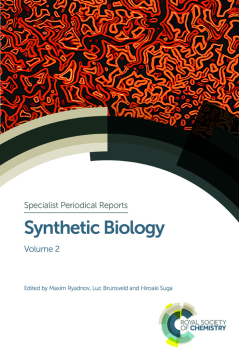
Additional Information
Book Details
Abstract
Synthetic biology combines science and engineering in order to design, build and test novel biological functions and systems. As with any multi-disciplinary field, there is a rapidly-growing body of literature concerning synthetic biology and locating the best information or identifying the hottest topics can be time-consuming. This volume captures the expanding primary literature in the form of critical and comprehensive reviews providing the reader with an authoritative digest of the latest developments in this emerging field. Each chapter strives to highlight the most recent findings in specific sub-areas and reviews research reports that were published over the last two to three years. Leading researchers draw material from both dedicated journals and broader sources, revising traditional concepts in light of emerging discoveries while keeping up with recent progress, making this an essential reference to any library supporting this research.
Table of Contents
| Section Title | Page | Action | Price |
|---|---|---|---|
| Cover | Cover | ||
| Contents | vii | ||
| Preface | v | ||
| Design and applications of synthetic information processing circuits in mammalian cells | 1 | ||
| 1 Introduction | 1 | ||
| 2 Input signals and inducible systems | 2 | ||
| 3 Designed synthetic circuits | 8 | ||
| 4 Therapeutic applications of synthetic biology | 23 | ||
| 5 Conclusions and lookout | 27 | ||
| Acknowledgments | 27 | ||
| References | 27 | ||
| Self-assembly at the multi-scale level: challenges and new avenues for inspired synthetic biology modelling | 35 | ||
| 1 Introduction | 35 | ||
| 2 Computational methods in self-assembly | 37 | ||
| 3 Force-field parameterization | 40 | ||
| 4 Applications | 44 | ||
| 5 MD-SCF models: applications in self assembly | 50 | ||
| 6 Conclusions and future perspectives | 57 | ||
| Acknowledgments | 58 | ||
| References | 58 | ||
| Protein scaffolds and higher-order complexes in synthetic biology | 65 | ||
| 1 Introduction | 65 | ||
| 2 Scaffold proteins | 66 | ||
| 3 Higher-order assemblies | 70 | ||
| 4 Mathematical models and simulations | 73 | ||
| 5 Synthetic scaffolds in engineered signalling networks | 83 | ||
| 6 Synthetic scaffolds in metabolic engineering | 92 | ||
| 7 Conclusions | 93 | ||
| References | 94 | ||
| Design of synthetic symmetrical proteins | 97 | ||
| 1 Introduction | 97 | ||
| 2 Symmetrical repeat proteins | 100 | ||
| 3 Symmetrical globular proteins | 105 | ||
| 4 Future perspectives | 110 | ||
| Acknowledgments | 111 | ||
| References | 112 | ||
| Designer proteins for bottom-up synthetic biology | 115 | ||
| 1 Introduction | 115 | ||
| 2 Designer proteins as mimetics of native assemblies | 116 | ||
| 3 Designer protein bricks | 118 | ||
| 4 Current trends: functionally applicable designs | 125 | ||
| 5 Future perspectives | 147 | ||
| References | 149 | ||
| Synthetic extracellular matrix approaches for the \r\ntreatment of myocardial infarction | 155 | ||
| 1 Introduction | 155 | ||
| 2 Healthy versus adverse remodeled cardiac niche | 156 | ||
| 3 Synthetic ECM approaches for the treatment of MI | 165 | ||
| 4 Discussion and future perspectives | 178 | ||
| References | 180 |
